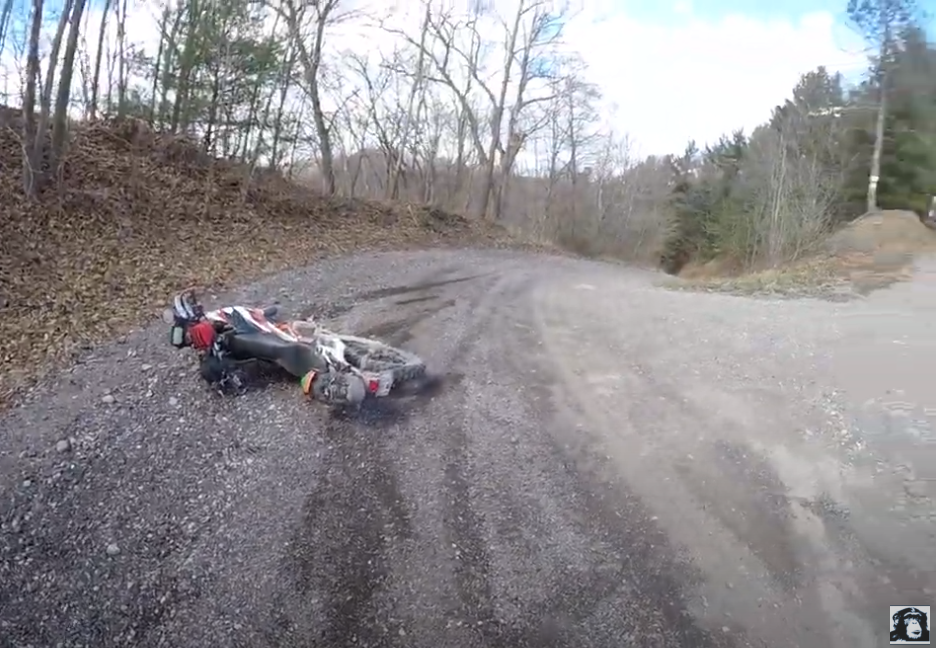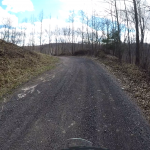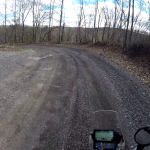I always say, “if you’re going to crash, at least have the god damned common courtesy to record it on GoPro so that the Internet can laugh at you” – so here we are! On a more serious note, the goal of this post is to do a detailed analysis to help others avoid the same fate. First, let’s watch the video so that you can see what happened for yourself. After the video, I’ll break down what I think went wrong and why.
Video
I’m riding along for about a minute, when I come up on a left hand turn on this gravel road. The front wheel washes out, and I come off the bike in what’s called a high side crash.
Facts
Let’s start with some quick facts about this crash:
- I was riding a section of the Criss Cross Apple Sauce route outside Salineville, OH
- I was riding a KTM 690 Enduro R with a Rade Garage rally tower
- I was going exactly 22 mile per hour when the front slid out
- I had almost all of the safety gear I could wear on: helmet, gloves, motocross boots, knee braces, pants and jacket with elbow, shoulder, back, and hip pads.
Breakdown
Now, I want to break this down using a lens of subjective and objective hazards, much like mountain climbers do. The idea is that you want to remove as much subjective risk as you can, things like not wearing a helmet. Once you’ve removed all subjective risk, you’re left with things you can’t control like an avalanche or a surprise storm.
I also want to break the accident up into two parts:
- The accident: this is what caused the bike to crash
- The injury: this is what what caused my leg break
The Accident
Objective Risk
Objective risks are risks that cannot be removed, no matter how much experience you have or how hard you practice. Good examples of objective risk include falling rocks, falling ice, avalanches, or errors of other people. There was no objective risk involved in this accident. This accident was entirely my own fault because I did not remove enough subjective risk. It’s difficult emotionally to admit this to myself, but it’s critical if I want to avoid accidents like this in the future.
Subjective Risk
Knowing that there was no objective risk involved in this accident, let’s move on to subjective risk, which are things I could have controlled. I’ll break this down as a set of bullets with examples of how I could have mitigated this risk. I’ve carefully worded each of these entries such that it’s difficult to argue with them even though people have differing opinions on some of them (ex. tire pressure).
- Speed: I think the number one problem is that I came into the turn too fast for the set of given subjective risks that day.
- Terrain: A secondary variable was the rut with loose gravel. I could have navigated it just fine if would have controlled my speed.
- Uncomfortable: As soon as I got off-road, I knew I was a little uncomfortable, but couldn’t put my finger on it
- Lack of Prescription Glasses: I wear glasses when I work on a computer, and sometimes when driving at night. I don’t wear them when riding on road, mountain biking, dirt bikes, or adventure bikes, but I probably should. I have a pair of glasses that I got a year ago, but the curvature of the lenses made it more dangerous. I literally dropped the glasses off at the optometrist today to see if they can add an anti-reflective coating, and I’m going to give them another try.
- New Helmet: I had a brand new Arai XD-4 on, and I was not used to the bubble shape of the visor. Normally, I wear goggles, but it was cold out, and I wanted to give the new helmet a try. The edges of the visor are definitely distorted in a way that I am not comfortable with yet.
- Used Front Brake: I’m a firm believer that you should absolutely use your front brake off-road and I reject the notion that you shouldn’t. That said, you should never use your front brake once you’re in the turn. It was a mistake, and I absolutely knew better from years of experience riding mountain bikes. I know that I used the front brake because I couldn’t see the terrain (helmet visor and lack of prescription glasses) which made me nervous and Ked to this mistake.
- Tire Pressure: People debate about whether you should be able to ride off-road with the same pressure as you run on-road. Regardless, this is the first time I had ridden the bike with 32 psi. It was an experiment on this day. I am used to running 18-20 psi on this KTM 690, and I’m used to running as low as 15 psi on my mountain bikes. I absolutely should have stopped and aired my tires down to a pressure I was comfortable with in this case. You could argue that I can learn to ride with 32 psi, but I was not comfortable or trained in riding that way when I crashed.
- Lack of Focus: I knew there were cliffs off to the right of that road, and I kept thinking about them the entire time. This gave me an irrational fear of riding off the road to the right, even just a little.
- Leaned and Turned: because of the irrational fear of cliffs, I didn’t try to ride it out straight. Instead I leaned and tried to turn, right before I hit the rut.
- Skills Development: I’m at that strange place in my skills development with riding off-road motorcycles where I need to take controlled risks. I’ve been through this development process on a snowboard, skis, mountain bikes, jumping ramps with BMX and dirt jumpers, power lifting, doing Jiu Jitsu, etc. It’s a naturally dangerous phase of your skills development where extra caution must be taken. Coincidentally, I had completed a two-day mountain bike class last summer, a one-on-one trials riding tutorial in January, I was signed up for two different off-road riding courses, and I was practicing off-road riding drills (brake, clutch, cone, balance, etc) multiple times per week.
- Overconfidence: I thought I knew the terrain better than I did. I had just ridden this part of the route a couple of days before the accident. This led me to think that I knew the road better than I did. This is almost always a mistake with riding anything off-road because it can change so fast with rain, weather or other vehicles moving the dirt and gravel around.
- High Winds: While I was riding out to this route, I encountered extremely high winds. They were the highest that I’d ever experienced on a bike, and I felt fine correcting for them on the pavement. I should have went even slower off-road. Some people have commented that I could have throttled through that rut, and I think that’s true in a low wind environment, but not in a high wind environment.
The Injury
Objective Risk
The injury itself was mostly objective hazard. Once you’ve crashed a bike, you really can’t control where it slides. I’m not sure I’m aware of anybody who is good enough to consistently crash in a way in which they have any influence whatsoever over the mass of the motorcycle once they’ve lost control. There is almost nothing more I could have done from a decision or protection perspective. The back of the bike slid around and hit my ankle while my toes were pinned in the gravel. I received a torsional fracture to my Tibia and Fibula. I received surgery and now have 18 screws and two plates, one in each bone.
Subjective Risk
- Reaction: I have a lot of experience crashing on snowboards, mountain bikes, skis, dirt jumpers, BMXs, etc. As soon as I realized I was crashing, I consciously reacted. I pushed off the bike, pulled my left leg up, and began preparing for my upper body to impact. I consciously curled my right hand a bit and extended my arms about 65-70% in preparation for impact. I was very much thinking about avoiding a wrist or collar bone injury and it worked. Regrettably, I absolutely felt my leg get caught. It felt soft, and I believe it was the tail bag. I heard or felt a snap, and I knew something had happened to a lower extremity, but I didn’t know which one.
- Head: I had an Arai XD-4 helmet on, but my head barely touched the ground (just the tiniest of scrapes on the visor)
- Ankle/Foot: I had Alpinstars Tech 7 boots on, which didn’t show any signs of damage
- Knee: I had Pod K4 knee braces on, which didn’t show any signs of damage
- Back/Shoulder/Elbow/Hip: I had a Thor Range Jacket and Pants (with D30 pads) on which didn’t show any signs of damage
- Hands: I had gloves on, which didn’t show any signs of damage. I had a pain in my pinkie knuckle on my left hand which hurt for about 2 days, which indicates a minor impact.
- Chest: I did not have any chest protection on, but did not receive any damage
Final Observations
From left to right, photo #1, #2, and #3 are screenshots from the GoPro footage in order from earlier in time, to later in time.
From photo #1, you can see the rally tower is barely in the shot. A few seconds later, in photo #2, you can see the GPS and 22 mph on the dash. This indicates that I was standing and crouched down to counteract the force from the front brake. This is something I’ve been drilling frequently on the mountain bike and dirt bike.
Perhaps, I could have reacted slightly more, paid more attention to my lower extremities when I came off the bike, but I don’t think so. Looking at photo #3, it’s pretty obvious that the bike spun around and caught my leg in an unpredictable, and uncontrollable way.
Anyway, I hope this blog helps others prevent mistakes like I made. Good luck, and here’s to riding, learning and finding adventure.




3 comments on “Crisscross Apple Sauce: The Crash That Broke My Leg”